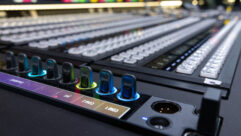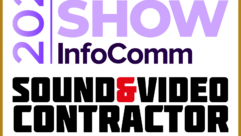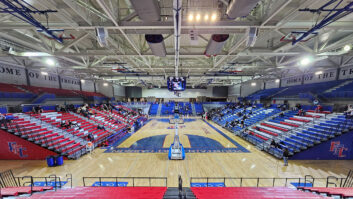
Technology Showcase:
HD Media Servers
Feb 1, 2006 12:00 PM,
By Jay Ankeney
Ingesting, storing, and delivering high-def multimedia.
Grass Valley Turbo iDDR
As more people become familiar with the benefits of high definition formats for video images and detailed graphic information, corporate IT departments are increasingly looking to install HD media servers in their executive boardrooms, training facilities, and public lobby areas. Fortunately, growing consumer demand for home theater is bringing down the cost of big-screen HD sets, which means installing large-format LCD, plasma, or projection displays throughout a corporate facility is becoming more affordable. In addition, as TV networks and stations migrate to HD programming, the server technology behind high-definition playout has also come down in cost.

Leitch Nexio HD server rack
THE ART OF MULTIMEDIA INGESTING
Several manufacturers provide turnkey high-definition media servers that can be installed in the equipment room racks of IT departments, the realities of moving high-definition content throughout multiple viewing areas can provide challenges as daunting as those HD images are dense. First, you need to get the high-definition material into the server, which is not as simple as ingesting familiar NTSC. Standard-definition sources, such as videotape or DVDs, present few complications, but ingesting HD content takes a different level of effort. Many say it is as much art as it is science.
Some HD media servers come with their own built-in encoders so that IT departments can directly feed their own material into them for upconversion. Or they can set up standalone HD encoding workstations to convert their source material into more manageable digital formats. But doing it yourself often requires investing in expensive HD playback decks, which can significantly increase the cost — and this approach risks obsolescence as the next wave of format technology washes ashore. Many smaller IT departments will find it more efficient to rely upon outside high-definition encoding services provided by postproduction houses in most markets.
The required distribution infrastructure will have to take into account that a compressed HD signal can be played out at a wide range of data speeds, from around 12Mbps at the low end up to 1.5Gbps for an HD-SDI (High Definition Serial Digital Interface) transmission as specified in SMPTE-292M. The ultimate display quality will vary accordingly. To add to the complexity, the ATSC (Advanced Television Systems Committee) has specified more than 30 formats for high-definition recording, although most display devices can handle the most common 18 of them invisibly thanks to internal conversion chips.
As the market shakes out, however, it is becoming apparent that 1080i (1920 pixels per line, 1080 lines per interlaced field) and 720p (1280 pixels per line, 720 lines per progressively scanned frame) are becoming the formats most widely accepted for HD acquisition and presentation. Just entering the marketplace are 1080p displays (1080 lines scanned progressively), what most TV engineers consider the gold standard. As bandwidth and storage space rise to accommodate the high density of 1080p, many hope it will become as ubiquitous as NTSC has been for the past 50 years. Of course, there are already production and display systems aiming at 4K resolutions and above, so the ultimate high end of what we now call high-definition displays has yet to come into sight.
Anyone considering installing an HD media server should bear in mind that it will also be called upon to deliver standard-definition material without necessarily upconverting to HDTV. There is also the slippery term EDTV (Enhanced Definition TV) under which many standard-definition signals are masquerading as high definition. Almost every large-format screen at your local consumer mega-mart draws crowds by displaying images from today’s DVDs and they’re really showing off EDTV. That’s because a universal standard for affordable high-definition discs is currently stalled in the titanic battle between HD DVD and Blu-ray disc, which is not only delaying its mainstream launch, but may even sidetrack these formats once competitors such as HDV and Windows Media Video 9 codecs aggressively enter the fray.

Electrosonic MS9100P
THE MARKETPLACE
As the prospect of viewing high-definition images in the corporate environment grows more attractive, an increasing number of companies are providing rack-mountable servers as the core of HD content distribution.
Just starting to ship this month is the new Soloist HD High Definition Digital Media Server from Adtec Digital, which leverages the company’s 11 years of experience creating embedded devices based on the company’s proprietary Video Transport Operating System (VTOS). The Soloist HD offers high-definition storage and a new Linux kernel for basic I/O. The Soloist HD supports MPEG-2 video in SD and HD as well as Windows Media Video 9, and after March it will also support H.264 files. With built-in logging and verification functions, the Solist HD comes with standard 80GB internal storage and can be controlled from its front-panel LCD screen or over LAN or WAN networks.
The Digital Video Machine HD Pro from Alcorn McBride offers HD-SDI output (SMPTE 292M) as well as an improved analog YPbPr output. Alcorn McBride is coming into the corporate server arena with 20 years in the theme park industry. Its Digital Video Machine HD plays hours of high-definition video at rates of up to 50Mbps (nearly three times the broadcast rate), and it can decode all ATSC formats, including 720p and 1080i. It also supports 1080p segmented frame. The Digital Video Machine HD converts between any formats on the fly, and it performs enhanced 3:2 pulldown on film-originated material encoded at 24p.
The Nugget from Doremi Labs is a cost-effective server for high-definition video playback. The Nugget plays standard-definition and HD MPEG-2 files up to 80Mbps for maximum-quality playback. Using the NugImport utility, an IT department can transfer video clips to the Nugget’s internal IDE drive via Ethernet. The clips can then be played in their native formats or upconverted or downconverted to any supported format, including 1080i, 1080p, and 720p. Doremi Labs’ Nugget Pro model adds HD-SDI output, bi- and tri-level sync, DVB/ASI input, and LTC I/O.

Leitch NX4200HDI
The Media Networks division of Electrosonic offers the MS9100P HD player, a rackmounted server that decodes the 18 popular ATSC formats through its MediaSonic MS9000 HD player control application or a Windows Media Player control application. A built-in MPEG format converter ensures that the source content is optimized for each display format, thereby eliminating the need for rescaling. Its big brother, the MS9200P server, has added features, such as genlock inputs for multi-channel and 3D systems, SMPTE timecode I/O, analog and digital output, and edge-blending capability.
Designed for large organization installations, the Mantis MG Enterprise Media Gateway media server from Focus Enhancements deploys numerous digital media applications across multiple locations. The Mantis MG supports up to four independent HD or eight SD outputs from a single rackmount system, plus an optional second hard drive (120HDD) for extra storage. It also features a “Watchdog” timer, a self-healing mechanism to reboot the player if it detects any failures, and WebView, an HTML-based user interface application that can remotely configure, monitor, and control the media player. The Mantis MG supports SD input and up-scaling to HD (1920×1080), and all digital content can be loaded onto the Mantis MG server via a standard DVD drive or a LAN network connection.
The IBM BladeCenter HS20, featuring up to two high-performance Intel Xeon processors, is a modular blade server that can store data on two internal hard drives with additional storage expansion available. The BladeCenter HS20 comes with two Gigabit Ethernet controllers standard and expansion capabilities for Fibre Channel, Ethernet, Myrinet, and Infiniband. Its proprietary Predictive Failure Analysis and IBM Director provide reliable management capabilities, while the BladeCenter HS20 distributes high-definition video via IP with the help of an external HD decoder throughout a corporate facility.

Adtec Digital Soloist HD
Leitch’s NX4200HDI, a low-cost, self-contained baseband HD video server, provides realtime HD/SDI I/O, network interfaces, ingest, playout, and FTP capabilities in a single chassis. Requiring no external encoder or decoder hardware, the NX4200HDI utilizes CPU power to code and decode HD video and audio. Recently equipped with standard-definition codecs, the NX4200HDI can mix MPEG and DV playback on the same timeline, and as of this month, it will have SD/HD up/downconversion capabilities. Because it’s part of Leitch’s Nexio server line, the NX4200HDI is upgradeable to Leitch’s fully featured NX4200HDX broadcast server.
With the ability to automatically upconvert standard-definition content to high definition, the Omneon Spectrum HD media server can play out HD and SD clips back-to-back at bit rates of up to 78Mbps. For every channel of input, the Omneon Spectrum HD provides two simultaneous outputs — one in HD, one in SD — so a facility does not have to purchase external conversion equipment for different clients to view the corporate feed. In addition, just at the close of 2005, Omneon became the first HD server capable of playing out native HDV files.
The first player-only media server from QuVIS, the QuVIS Ovation, utilizes its own QPU wavelet compression to serve up video formats ranging from NTSC through HD, 2K, and beyond. The QuVIS Ovation may be configured to play back more than 10 hours of 1080i or 720p HD video from internal storage, and it offers expandable external storage capabilities. Its rack-mountable design incorporates 1-1000X forward/reverse search speed controlled by an RS-232/422 interface to a remote PC, while user-friendly tools help create sophisticated playlists.
Bringing the technology from its Emmy-winning Profile video servers into the pro AV marketplace, Thomson’s Turbo iDDR (intelligent Digital Disk Recorder) is part of its Grass Valley ProLine and can hold 10 to 40 hours of storage. Introduced at InfoComm International 2005, the cost-effective Turbo iDDR can output two channels of compressed HD. With its integrated front control panel, the Turbo iDDR leverages computer/video-centric components such as CD-ROM and DVD drives, USB memory sticks, and external USB devices. It can import Windows Media video and, in its latest version, also QuickTime 7 and JVC or Sony HDV files over IEEE 1394 FireWire.
For More Information
Adtec Digital
www.adtecinc.com
Alcorn McBride
www.alcorn.com
Doremi
www.doremilabs.com
Electrosonic
www.electrosonicmedianetworks.com
Focus Enhancements
www.focusinfo.com
IBM
www.ibm.com
Leitch
www.leitch.com
Omneon
www.omneon.com
QuVIS
www.quvis.com
Thomson
www.thomsongrassvalley.com










